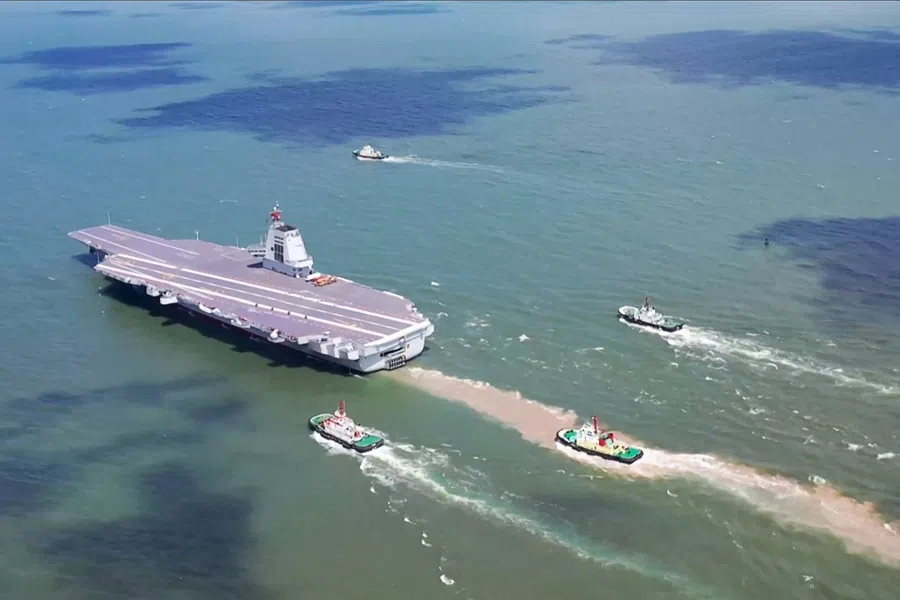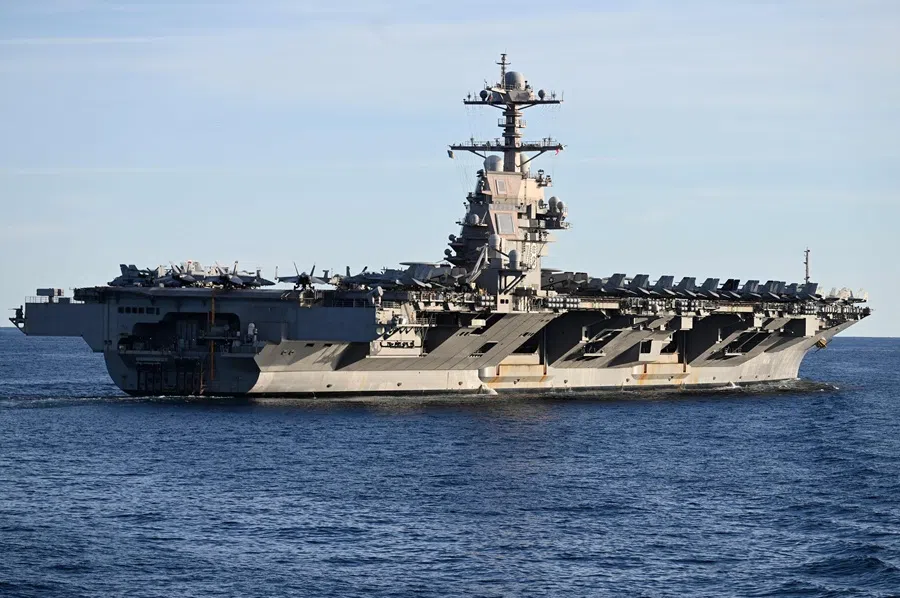China’s Fujian hits the water — next carrier already in the works
The Fujian launches the J‑35 stealth fighter via electromagnetic catapult, while satellite photos reveal China’s nuclear Type 004 carrier is already being built at Dalian. Lianhe Zaobao correspondent Yu Zeyuan takes a look at how China is transforming the military strategic landscape of the western Pacific.

On the afternoon of 5 November, China’s top leader Xi Jinping held a commissioning and flag presentation ceremony for China’s third aircraft carrier, the Fujian, at Sanya Naval Port in Hainan, officially marking the beginning of China’s “three-aircraft-carrier” era.
A successful electromagnetic catapult system
The Fujian, bearing the hull number “18”, is China’s first aircraft carrier equipped with an electromagnetic catapult system (EMALS). It was launched and named in June 2022, and conducted its first sea trial in May 2024. The carrier has a displacement of over 80,000 tonnes, and its power system can reach a total output of 280,000 horsepower, significantly surpassing the 200,000 horsepower of China’s first two carriers, the Liaoning and the Shandong. The Fujian can reach a maximum speed of 30 knots, slightly slower than the US’s Nimitz-class nuclear-powered carriers.
By using a medium-voltage direct current (DC) architecture, Fujian has successfully demonstrated a path for conventionally powered carriers to operate an EMALS.
The USS Gerald R. Ford aircraft carrier continues to experience issues with its EMALS. Amid these ongoing challenges, US President Donald Trump reportedly suggested that the military consider returning to traditional steam catapults. Meanwhile, the Chinese carrier Fujian has emerged as one of the world’s most technologically advanced carriers. In a world-first achievement during sea trials in September 2025, it successfully launched a fifth-generation stealth fighter, the J-35, using EMALS.
The Fujian is also the world’s first conventionally powered carrier equipped with an EMALS, which requires a robust and reliable power supply. In contrast, the US Ford-class carriers, despite having abundant nuclear power, have faced a high failure rate with their EMALS, linked to complex AC-based motors and delicate wiring. As a result, no Ford-class carrier is publicly documented as being fully certified for sustained F-35C operations at sea. By using a medium-voltage direct current (DC) architecture, Fujian has successfully demonstrated a path for conventionally powered carriers to operate an EMALS.

The Fujian is also the first carrier in the world capable of launching fifth-generation fighter jets using the EMALS. In September this year, state media released videos of the Fujian successfully launching the J-15T, the fifth-generation fighter J-35 and the KJ-600 surveillance aircraft, demonstrating the good compatibility between China’s independently developed electromagnetic catapult and arrestor systems with a variety of carrier-based aircraft. This lays a solid foundation for integrating other carrier-based aircraft, including drones, into the carrier strike group system.
... the electromagnetic catapult system on the Fujian enables fighter jets to take off with a full load of fuel and ammunition.
Boost in combat capabilities
The Guancha Syndicate (观察者网) quoted military academic Zhang Junshe as saying that the aircraft launch technology on the Fujian represents a generational leap, moving from the ski-jump takeoff used by the Liaoning and Shandong, leapfrogging the steam catapults of Western countries and directly adopting electromagnetic catapult technology. This can be considered a “catapult revolution”, achieving significant advancements in three areas.
Firstly, the combat capability of carrier-based fighter jets would be greatly enhanced. The J-15T cannot take off with a full load of fuel and ammunition on ski-jump takeoffs, affecting the fighter jet’s combat radius and range. If it is fully fuelled, the amount of ammunition it can carry might have to be reduced. However, the electromagnetic catapult system on the Fujian enables fighter jets to take off with a full load of fuel and ammunition.
The second advantage is the improved combat efficiency of the aircraft carrier. The Shandong once carried out 570 aircraft sorties over nine days, averaging 63 per day. The Fujian, however, can launch a J-15T fighter in just about 90 seconds, meaning that at surge capacity, it can handle 270 to 300 sorties per day.

The third advantage is a leap in the People’s Liberation Army (PLA) Navy’s combat capability. Zhang noted that, compared with the early-warning helicopters used on China’s first two carriers, the catapult-launched KJ-600 has a much greater reconnaissance and early-warning range. It can warn the carrier group several hundred kilometres out at sea, letting the formation see further and respond faster. Paired with J-15T and J-35 fighters, the early-warning aircraft can form a complete far-sea offence-defence combat system, significantly enhancing the PLA Navy’s blue-water combat capability.
Combined with China’s powerful coastal missiles and rapidly growing air force, the country has now acquired an initial capability to contend with the US in the western Pacific.
However, military academics have also pointed out that the Fujian is still a conventionally powered carrier, so its range and sustained combat capability remain inferior to those of the US Navy’s nuclear-powered carriers. Also, the PLA Navy lags behind the US Navy in terms of carrier group coordination, and the proficiency of carrier-based aircraft pilots, especially in actual combat experience.
The next aircraft carrier
That said, the Fujian’s commissioning will significantly boost the PLA Navy’s overall strength for missions in the Taiwan Strait and the South China Sea. Combined with China’s powerful coastal missiles and rapidly growing air force, the country has now acquired an initial capability to contend with the US in the western Pacific.
According to reports from media outlets such as Military Watch Magazine, satellite imagery indicates that construction has already begun on China’s fourth aircraft carrier (Type 004) at the Dalian Shipyard, and a keel-laying ceremony may be held within the next few months.
Military analysts speculate that the Type 004 will be nuclear-powered, with a full-load displacement of over 110,000 tonnes. This would make it the first nuclear-powered aircraft carrier ever built by a non-Western navy. Equipped with advanced electromagnetic catapult technology, its performance is also expected to surpass that of the US’s latest Ford-class carriers.

In February, satellite images of the Dalian Shipyard revealed large modules consistent with carrier flight deck structures. By September, large-scale assembly of prefabricated hull sections and modules had begun in the dry dock. In just half a year, China completed the preliminary preparations for the aircraft carrier’s construction. It is expected to use modular assembly methods to significantly shorten the overall building time.
Reports suggest that China’s Type 004 nuclear-powered aircraft carrier will be launched in 2027 and enter service around 2030. By then, the military strategic landscape of the western Pacific will be further transformed.
This article was first published in Lianhe Zaobao as “中国开启“三航母”时代”.





